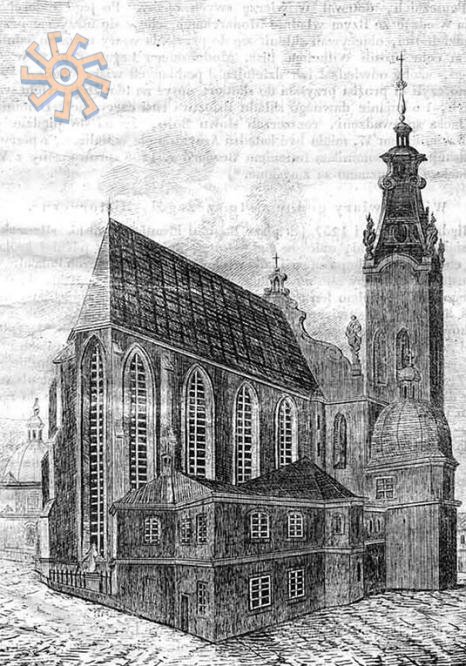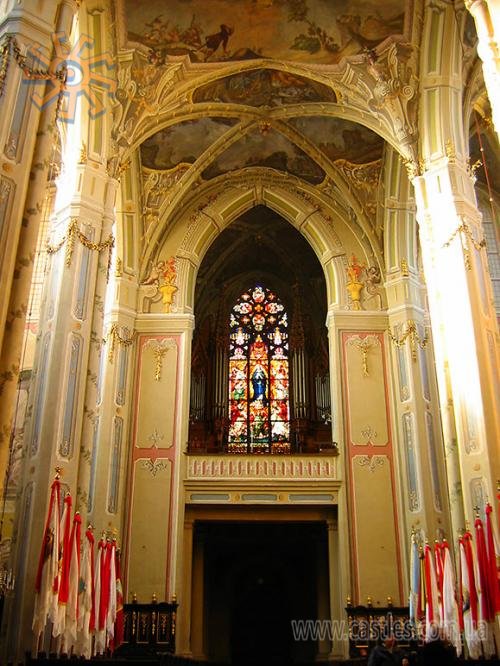|
|
|
|
Lviv's Cathedral by Aloizy Tomaszewski. 1835 |
Lviv. In the cathedral. January 2005 |
Translated by Dictum Factum (Kyiv)
The main Catholic church in Lviv, Lviv’s area, and probably in all Ukraine. It is widely-known, but nevertheless we’ll repeat its history.
Permission for the erection in Lviv of the cathedral church was given to the king Casimir in 1360 by the Avignon curia (in that time, the residence of Pope was situated in Avignon, not in Rome). The foundation was laid in 1368, and the construction, as happened everywhere in Europe with large Gothic cathedrals, lasted for a long time. In the case of the city - almost two centuries. And how many reconstructions were there! Not surprisingly, that this church is a kind of textbook of architectural styles: from Gothic and Renaissance to Baroque and Rococo, and than – to Modern.
In 1405 a part of the church (the author of the project was Mukola Nuhka) was consecrated by the Peremushlskiy Bishop Matei, but the status of the cathedral it received already in 1412-1414, when to the town from Galich was transferred Roman Catholic Archdiocese. In 1481 the cathedral presented a tripartite Gothic building from a red brick.
In 1645 in the Domahalychiv’s chapel was placed so-called "miraculous" icon of the merciful Mother of God (1598). This icon is extremely important for Poles: just in front of it in 1656 the King John Casimir made a solemn vow and called Madonna the Queen of Poland. 
Cannonballs are immured into the eastern wall of the church, as a reminder of the Turkish siege of the city in 1672. This also states the inscription over the biggest cannonball: «Ex obsidione turcica». (Polish weekly Tygodnik Ilustrowany for 1867 in its summary of the cathedral cites the whole inscription from the cannonball: it's amazing how on one iron ball could be so many - almost fifty! - pathos words). Above it, is placed a ball with the inscription «Ex obsidione ruthenorum» («From the Ukrainian siege») - recollection of the events of March 1919 and the Ukrainian-Polish war. On the same east wall of the street, from a side of Galician street, is situated an icon, set by the famous geometer Josef Volfovich in memory of premature death from a disease of his 9-years-old granddaughter Catherine, the daughter of Wojciech Domahalycha. That happened in 1598.
A restructuring of the cathedral in a baroque style began in 1760 with a participation of Lviv’s architect Peter Poleyovskiy. At that time the church was almost in an emergency condition. The old vitaras and chapels were dismantled and rebuilt, as well as new ones were built. The miraculous image was transferred to the main altar of the shrine. Stanislav Sroyinskyy painted the interior of the church in 1769-1775. In 1776 the "miraculous" icon was crowned, and the church was declared a sanctuary of the merciful Mother of God.
Not everybody liked a baroque appearance of the major Catholic shrine of Lviv: in the late nineteenth century, when a fashion for neo-Gothic existed, a committee led by Bishop Jan Puzyna decided to restore the building a Gothic appearance. But the initiative of Lviv’s clergy didn’t find any support at the summit, in Vienna. As a result, only presbytery was rebuilt. In 1910 Pope St.Pius X conferred to the cathedral the title of a small basilica.
In those Austro-Hungarian times the cathedral had two ambones: one for the Polish community of the city, and another-for its German-speaking residents. Formally, the masses in German were also to be celebrated in other churches of the city, but all of them avoided somehow this duty (Dominican monks kept for such purposes a German chaplain, who didn’t do anything, Jesuits’ learned diligently German language, but didn’t rule by it, etc.), but the cathedral by it’s status could not allow itself such kind of a course.
The cathedral until now has preserved many old and valuable tombstones. The most valuable among them as far back as in the nineteenth century was considered Krosnovskiy’s tombstone in the chapel of the Most Holy Sacrament, as well as gravestones with the names of the Kampian’s family - in the chapel of their own, Kampian’s name.

The main Catholic cathedral of Lviv has one main (1765-1771 designed by P. Polejowski), two side (lateral) vitaras (1773-1776) and eight chapels. The Renaissance chapel of Kampians’ (the chapel of Scourged Jesus) was built in 1585 at a place of the chapel of Mother of God, by the Strumyliv’s family. The construction was completed in the XVIIth century. The architects were Pawlo Rymlyanyn and Andriy Bremer. The walls of the chapel are masterly decorated with carvings on the Gospel stories. Black marble altar was made by the Dutch artist Henryk Horst (1580-1586). The vault of the chapel was painted in 1774-1775 by S. Stroyinskyy. In 1905 the chapel was thoroughly restored (architect Wladislaw Sadlovski, artist Henryk Kyuhn).
The Chapel of Mother of God and St. Anthony was built in 1770-1780-ies and painted by S. Stroyinskyy. An altar, in rococo style, comes from the 1770-ies.
The Chapel of The Wysznioweckis (Gold or Blessed Gifts) is one of the oldest in the building. It was constructed for the funds of Anna Buchach in 1495, as a chapel of the Blessed Virgin and St. Stanislaw. Its development took place in 1587, at the end of the XVIIth century and in the 1733-1770 (at the expense of the Prince John Vishnevetskiy the last reconstruction of it was).
The Chapel of Merciful Christ and Mother of God of Perpetual Help was built in 1628 at the expense of Peter Milevskiy and later rebuilt in the late baroque style, and in 1904 - in the modern style (architect Sadlovskyy). And at that time the chapel was painted by Lviv’s artist Myron Petsh.
At the place of the chapel of Merchants, in the XVIIIth century, was built the Chapel of Czestohowska Mother of God. The polychrome was performed by S. Stroyinskiy in 1774-1775. The Chapel of Crucified Jesus (of Yablonovskih) was built in 1769-1771 at the place of the Councilors’ chapel in 1454. The painting, made by S. Stroyinskym in the 1773-1775, was restored in 1930. An altar was made by the sculptor J. Obrotski in 1775.
The Chapel of St. Casimir (built in the XVIIIth century at the place of the Chapel of Polish Saints and was restored in 1871) is decorated with the late baroque altar, beginning from 1875 (sculptor J. Obrotski).
The Chapel of St. Joseph (Zamoyski's) appeared during a baroque reconstruction of the church at the place of St. Anna’s chapel (XVIth century) and presented a sepulcher for the Archbishop Jan Zamoyskiy. An alabaster altar of the late Renaissance was made in 1592 by Cracowian Jan Byalyy.

In Soviet times, the church continued to work. I perfectly remember what a huge impression made on me a Mass, which I visited here being a child in the spring of 1986. It was the first Catholic act of worship, which I saw in my life (Kamenetz cathedral was in those times, the museum of religion and atheism). Respected men in white vestments and with a kind of flags, or banners surprised me – come on, they are already grown-up, so why they are behaving like children? But paintings and altars of the cathedral seemed to me extremely luxurious. I admitted with sadness for myself that our cathedral looks less impressive in comparison with Lviv’s cathedral : o) One more time, I confirmed this fact in 1993 then in 2001, then began to visit the main Catholic shrine of Lviv with the steady impressions - and since then had never ever compared it with the churches of my home town : o)
Not far from the cathedral is situated the Boim’s chapel of the late Renaissance (1609-1615, a supposed architect is A. Bremer), which is also closely linked to the main Catholic shrine of Lviv. The building is impressive: it seemed that a traditional chapel was turned inside out and an iconostasis was found out outside: a facade covered with a very nice carving, doors guarded by lions with gags in a form of rings in their muzzles, and on the roof - crestfallen Christ. The interior continues the line, initiated by the western facade: caisson on the dome, eloquent epitaphs, winged angelic heads, crucifixes, figures and figurines - a talent of the master of the beginning of XVIIth impresses even nowadays. Sculptural decoration that remained almost unchanged probably was made by the masters J. Pfister, G. Stoltz, J. Biluy and S. Cheshek. The lower tier of carving, which was created by an unknown artist, was simpler. The middle of the eastern wall, made by G. Stoltz is much more expressive, and a well-known master of that time J. Pfister had a hand in its dome. Two family portraits on the western wall - the remains of Boim’s family gallery. On the south wall remained intact two carved epitaphs of Pfister.
On March 2d 1991, for the first time in 58 years, in the Lviv’s Cathedral was held an Episcopal ordination. The church was renovated in 1999-2001. Pope John-Paul II visited the cathedral on June 25, 2001. In honor of the Pope on June 25, 2003 on the wall of the building was installed a memorial plate.
The chapel was restored in 1927

|
|

|

|

